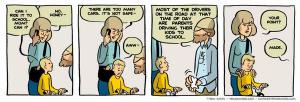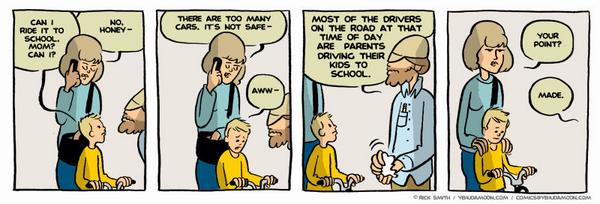
“It’s not the first two streets that are the problem; she can cross those. It’s that last street, because it doesn’t have a stop sign. And people drive SO fast through town.”
We stood in one small circle of conversation among many others, the room buzzing with questions about the first week of school. Flocks of small children swooped around our legs, swiping cups of lemonade before flying off to bring mayhem to some formerly-quiet corner of the church.
“It’s frustrating, because I really, really wanted her to ride the bus to school. It’s good for her to learn to take the bus and to have that independence, and to know that if she’s not out there on time she’ll miss it.”
I play with the edges of the paper coffee cup, folding the handle up and down as I listen. The coffee is thick and almost greasy somehow, leaving its mark on the sides of the cup.
“But I have other kids, too – honestly, if I have to wake them up anyway to walk her to the bus stop, it’s just easier to stick them in their car seats.”
Yes, the agony of organizing multiple children for school runs. Pulling the sleeping child out from under their blankets, draping that floppy, unwilling weight over your shoulder as you run out the door, returning to the house to pull a second droopy kid from bed. Tears falling from those bleary eyes, always, mama frazzled and late.
We talked through a couple of possibilities. There aren’t any other kids on her block going to the same bus stop, so a walking school bus (uh… to the school bus?) is out. The problem is that one street that’s hard to cross.
Almost all of the east-west streets around here stop at every intersection, but the north-south streets normally go eight blocks or so between stop signs. Of course, this means that traffic on these streets is much faster and that they’re more difficult and dangerous to cross. They’re designed so that people passing through by car can make good time – but they don’t add value to our neighborhoods.
I can think of three women just off the top of my head this morning who are driving their kids to school because there is a street too busy for their child to cross. I accompany my capable children every day for this same reason. The profound irony of this, of course, is that 20% or more of morning traffic is made up of parents doing just that. Which comes first, the chicken or the egg?
When we begin to talk about a Montessori City, we’re talking about a place where kids can practice age-appropriate behaviors without being unnaturally constrained by their environment. This is entirely do-able, but it’s going to require us to make some changes – and the sooner we allow our kids to live full lives right in their own neighborhoods, the better off our whole community will be down the road.
“It takes me seven minutes to walk her to the bus stop, longer if her little brother insists on walking. It takes me ten minutes to drive her to school. I think I’ll let her take the bus home, but I’m going to start driving her to school. This just isn’t working.“









